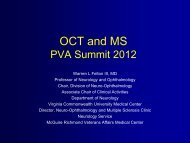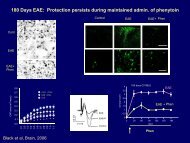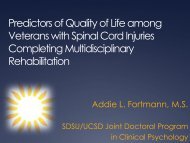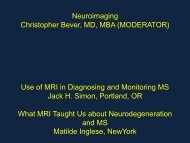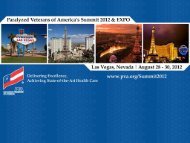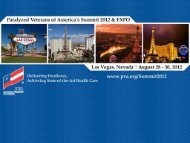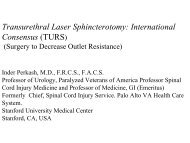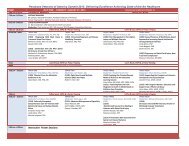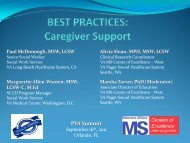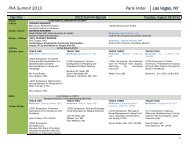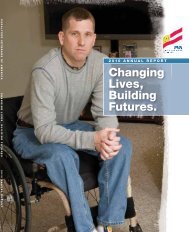Cassandra Miller-Hardwick, MSN, RN, CRRN
Cassandra Miller-Hardwick, MSN, RN, CRRN
Cassandra Miller-Hardwick, MSN, RN, CRRN
You also want an ePaper? Increase the reach of your titles
YUMPU automatically turns print PDFs into web optimized ePapers that Google loves.
Deborah L. Downey MN, CN<strong>RN</strong>, ANP-BC<br />
Heidi Maloni, PhD, ANP-BC<br />
<strong>Cassandra</strong> <strong>Miller</strong>-<strong>Hardwick</strong>, <strong>MSN</strong>, <strong>RN</strong>, CR<strong>RN</strong>
Disclosures<br />
• Deborah Downey<br />
• Has no financial interest or relationships to disclose<br />
• Heidi Maloni<br />
• Has no financial interest or relationships to disclose<br />
• <strong>Cassandra</strong> <strong>Miller</strong>-<strong>Hardwick</strong><br />
• Has no financial interest or relationships to disclose
Learning Objectives<br />
• At the conclusion the participant will be able to:<br />
• Recognize and understand the unique care needs of SCI,<br />
MS, and ALS veterans across all settings.<br />
• Identify and discuss competencies expected to meet the<br />
needs of this patient population.<br />
• Identify ways to enhance collaboration and networking<br />
among nurses providing care for SCI, MS, and ALS<br />
patients.
Abstract<br />
• Spinal cord injury (SCI) nurses practice with expertise and<br />
competencies in managing key issues in spinal cord disease.<br />
• SCI nurses practice typically in the inpatient and<br />
rehabilitation setting.<br />
• Multiple sclerosis (MS) nurses practice with expertise in the<br />
care of the veteran living with MS most commonly in<br />
outpatient settings and home based care.<br />
• Patients with amyotrophic lateral sclerosis (ALS) receive<br />
care from nurses in a variety of settings to include: Spinal<br />
cord injury, Pulmonary, Medicine, Neurology and Homebased<br />
primary care.
Abstract<br />
• The advent of Spinal Cord Injury and Disease<br />
integration has expanded practice guidelines,<br />
blended roles, and traversed settings of care for<br />
nurses who care for SCI, ALS and MS patients.<br />
• This session aims at meeting the SCI, ALS and MS<br />
patient needs through understanding best<br />
practices in both SCI, ALS and MS nursing care<br />
across settings and across diseases.<br />
• The session will adopt a case study approach with<br />
the aim of integrating best practices and<br />
optimizing care for SCI, ALS and MS patients.
Abstract<br />
• SCI case studies will emphasize care needs related<br />
to bowel, bladder, skin, and autonomic dysreflexia,<br />
prevention and management;<br />
• MS case studies will emphasize care needs related<br />
to cognition, immunization, complementary and<br />
alternative medicine, and disease modifying<br />
therapies; and,<br />
• ALS case studies will emphasize care needs related<br />
to diet, respiratory, communication, and assisted<br />
technologies
• Continuing and facilitating the care of spinal cord<br />
patients that require care on an acute med/surg<br />
unit requires a strong collaborative relationship<br />
between inpatient SCI/D nurses and acute care<br />
nurses<br />
• It is vitally important that we provide ongoing<br />
support and education for med/surg colleagues to<br />
ensure the continuation of basic SCI/D cares and<br />
services until the patient is stable enough to<br />
transfer to the SCI/D center.
Off-service Care<br />
• SCI/D patients are admitted to the Medicine Service for<br />
a variety of reasons, including but not limited to<br />
• Urosepsis, Pneumonia, DVT, Cardiac events, and other<br />
diagnosis requiring Internal Medicine specialty care.<br />
• Regardless of the reason for an admission to an acute<br />
unit, the following nursing care needs are of significant<br />
importance:<br />
• Bowel and Bladder management<br />
• Pressure Ulcer prevent and management<br />
• Mobility issues<br />
• Equipment needs<br />
• Preservation of Independence<br />
• Autonomic Dysreflexia prevention and management
Bowel and Bladder Management<br />
• Continuation of established Bowel and Bladder<br />
management programs is vitally important and requires a<br />
collaborative approach that includes the patient and the<br />
SCI/D team.<br />
• One of the challenges that patients face is the inability to<br />
maintain established routines.<br />
• Incorrect orders or inadvertent changes in bowel and bladder<br />
program<br />
• Staff competency/comfort/willingness to perform steps of the<br />
established bowel program<br />
• Changes in bladder drainage method upon admission by admitting<br />
provider
Pressure Ulcer Prevention and Mgmt<br />
• Establishing appropriate pressure ulcer related activity<br />
orders is important to promote healing and patient<br />
independence<br />
• The correct bed frame and mattress is also very<br />
important! One size does not fit all<br />
• Bed rest is not always required for patients with<br />
pressure ulcers.<br />
• Innovative approaches to PU management can allow<br />
the patient time up in their chair throughout the day<br />
• Strict sitting and turning and repositioning schedules<br />
can be challenging on non-rehab units
Equipment Needs<br />
• Bedside equipment<br />
• Alternative Call lights systems<br />
• Soft touch<br />
• Sip & Puff<br />
• Tent<br />
• Other types<br />
• Bed control options/Assistive technology<br />
• Appropriate Commode/shower chair options
Mobility and Independence<br />
• Storage and maintenance of wheelchairs in a<br />
standard hospital room. Is there room for the<br />
chair?<br />
• Power wheel chairs with elaborate accessories<br />
• Lateral supports<br />
• Head array<br />
• Various control options<br />
• Limb support<br />
• Proper installation/positioning of cushions
Autonomic Dysreflexia Prevention and<br />
management<br />
• All of the areas discussed can have a potential<br />
impact on the development of Autonomic<br />
Dysreflexia (AD) in patients at risk<br />
• It is vitally important that our acute care/Med-<br />
Surg colleagues are aware of the signs and<br />
symptoms of AD and the importance of Listening<br />
to the patient when it comes to this life threating<br />
emergency
• As you can seem our patients face many<br />
challenges when they are admitted to a non-<br />
SCI/D unit in addition to the medical reasons<br />
for the admission.<br />
• There are also unique issues related to<br />
Outpatient Care for SCI/D patients<br />
• Initial and Ongoing education/training for all<br />
nursing staff in the following areas is very<br />
important to facilitate continuation of<br />
established care routines:
• Bowel and Bladder management<br />
• How to preform a proper bowel program<br />
• Specific competency for use of specialty catheters<br />
• Instructions on how to obtain specialty catheters<br />
• Pressure Ulcer prevent and management<br />
• Ongoing training and education on pressure ulcer<br />
management with special focus on the needs of SCI<br />
patients<br />
• Early involvement of the WOCN for guidance and<br />
consultation related to PU treatment, bed/mattress<br />
selection
• Equipment needs<br />
• Availability of alternative call lights<br />
• Annual SPH competency for staff<br />
• Increase availability of commode/shower chairs<br />
Mobility issues<br />
• Involve PT and OT colleagues when needed for Just in<br />
time training related to wheel chairs and cushions<br />
• Autonomic Dysreflexia prevention and<br />
management<br />
• Initial and ongoing education and training for all staff<br />
Autonomic Dysreflexia prevention and management
• Continuing and facilitating the care of spinal cord<br />
patients that require care on an acute med/surg<br />
unit requires a strong collaborative relationship<br />
between inpatient SCI/D nurses and acute care<br />
nurses<br />
• It is vitally important that we provide ongoing<br />
support and education for med/surg colleagues to<br />
ensure the continuation of basic SCI/D cares and<br />
services until the patient is stable enough to<br />
transfer to the SCI/D center.



